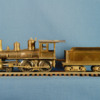It's now been over 2 years since I got my Great Western 4-4-0 - It's been sitting on a shelf all that time, always bothering me with how close - yet so far - it is from being a proper scale model, the proportions off just enough to not look quite 'right'. I had always thought that the cab needed to be shorter and the entire boiler needed to be lowered and moved back. Well, I've finally got free time again to work on these old models (I've gotten a '31 Ford that I've been working on for the last couple years in my free time), so I decided to finally tackle correcting this model. It's not done, but I've made significant progress.
I first started by fabricating a new cab out of brass - this was really a test of my skills, and is probably the most complicated part I've fabricated so far, but I'm very happy with how it turned out. I based the dimensions of the cab on CP 173, due to the fact that it shares similar dimensions and 54" drivers.



I then fit the cab to the loco, being very careful to set the running board in the correct positions for soldering. Also note that it now has the correct tender trucks, that I very fortunately stumbled across on Ebay.

And then lowered the whole boiler 1/8", requiring much of the running boards, frame, and steam chest to be cut and filed down...

I then reworked the pilot, moving it backwards 1/8", and doubling the number of bars from 11 to 21. I intend to set this loco up with link and pin couplers, note the WIP front link sitting next to it. I'm experimenting with actually forging the front link from a brass bar like the real thing. The holes in the end of it were punched through and expanded, rather than drilled.

I also cut the side boards off the tender in preparation for shortening the tender tank 3/16", such that the top of the tank is lower than the cab windows. I'll then fabricate a new top cover to the tank.

And here it is sat next to my GMC pacific for scale...

I've still got a long way to go, but I'm very happy with how it's turning out. I don't believe I've seen any properly proportioned 4-4-0 models of this age, so I'm very happy to have one for myself. There is a bit of a dilemma of whether or not a model of this age and rarity should be so modified, but it's certainly still a Great Western 4-4-0 at its core, and the modifications really are showing its potential.
I've been debating how I'm going to power it - I don't think I can obtain an original drive for it, so I'm going to retrofit a NWSL 253-6 gearbox into it, with a motor in the tender. I believe it came with a Pittman DC92 originally, but those stick out the top of the tender quite a bit. I've tried a DC91, which looks like it ought to fit, but doesn't quite. I've also got a Pittman can motor that does fit very well, but I'd much rather use a period correct motor. I'm considering a DC71 - I've bought one from Ebay to see how it will fit. They're typically HO gauge motors, but ought to fit this loco. I just don't know if it will be powerful enough, but this is a small loco, and will only ever pull 2-3 cars at most.
















































